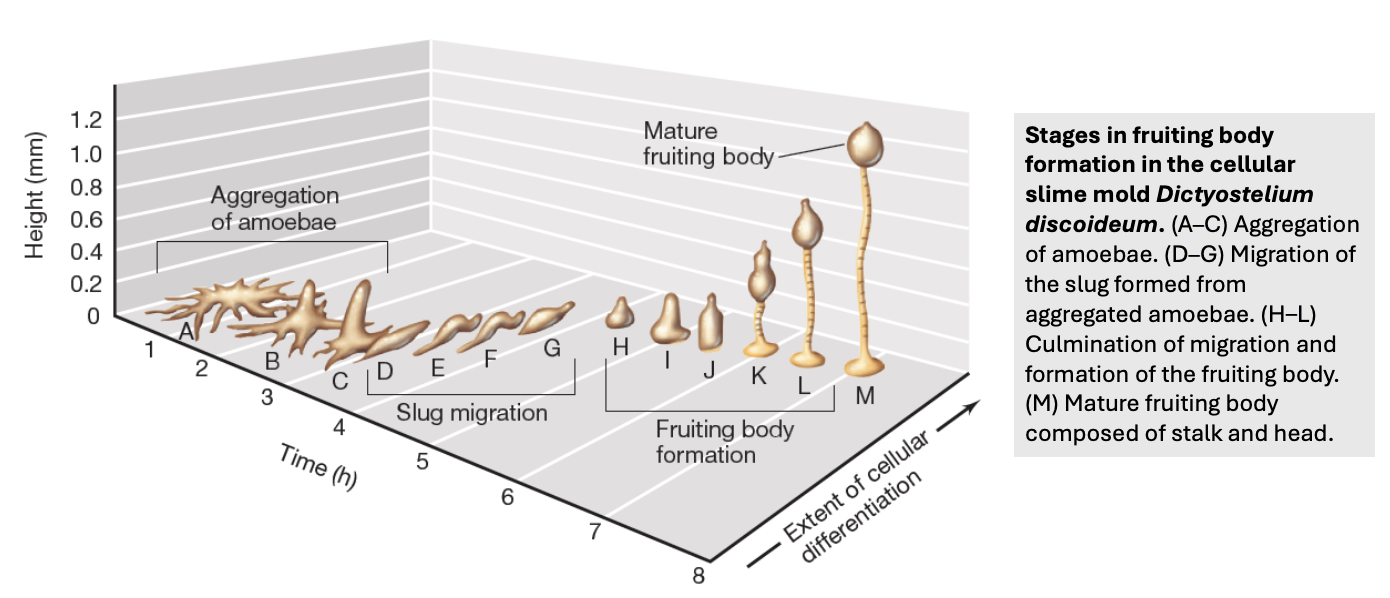MYCO 2.1C Fungus-like organisms
1/53
There's no tags or description
Looks like no tags are added yet.
Name | Mastery | Learn | Test | Matching | Spaced |
|---|
No study sessions yet.
54 Terms
_ are 5 non-taxonomic ranks resulting from primary and secondary endosymbiosis
Eukaryotic supergroups
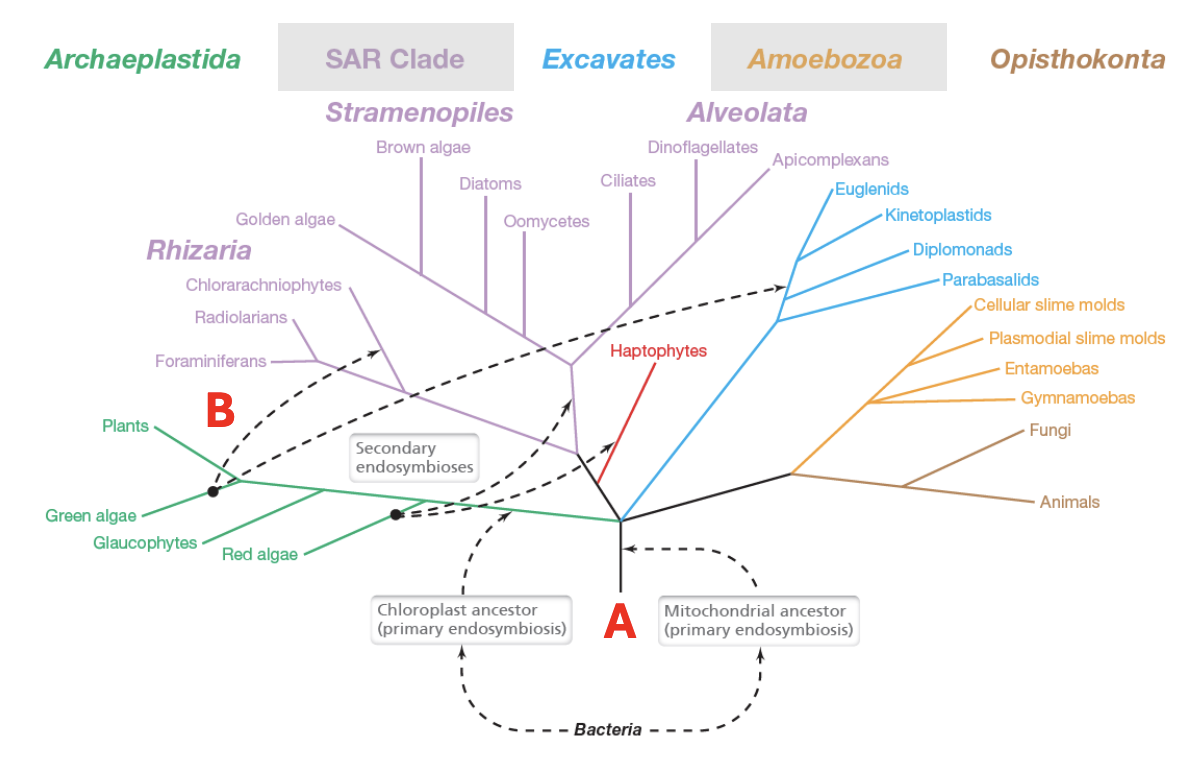
Enumerate 5 eukaryotic supergroups
ase ao
Archaeplastida
SAR clade (Straminopiles, Alveolata, Rhizaria)
Excavates
Amoebozoa
Opisthokonta
_ include heterotrophic and phototrophic protists with common ancestor
SAR clade (Straminopiles, Alveolata, Rhizaria)
_ include many forms of amoebae and slime molds, underwent only primary endosymbiosis
Amoebozoa
Primary vs. Secondary endosymbiosis
Primary (eu + p) = eukaryotic cell engulfing free-living prokaryote that eventually evolves into 2-membraned mitochondria or chloroplast
Secondary (eu + eu) = eukaryotic cell engulfing eukaryotic cell, eventually evolving into 3-4-membraned complex plastids
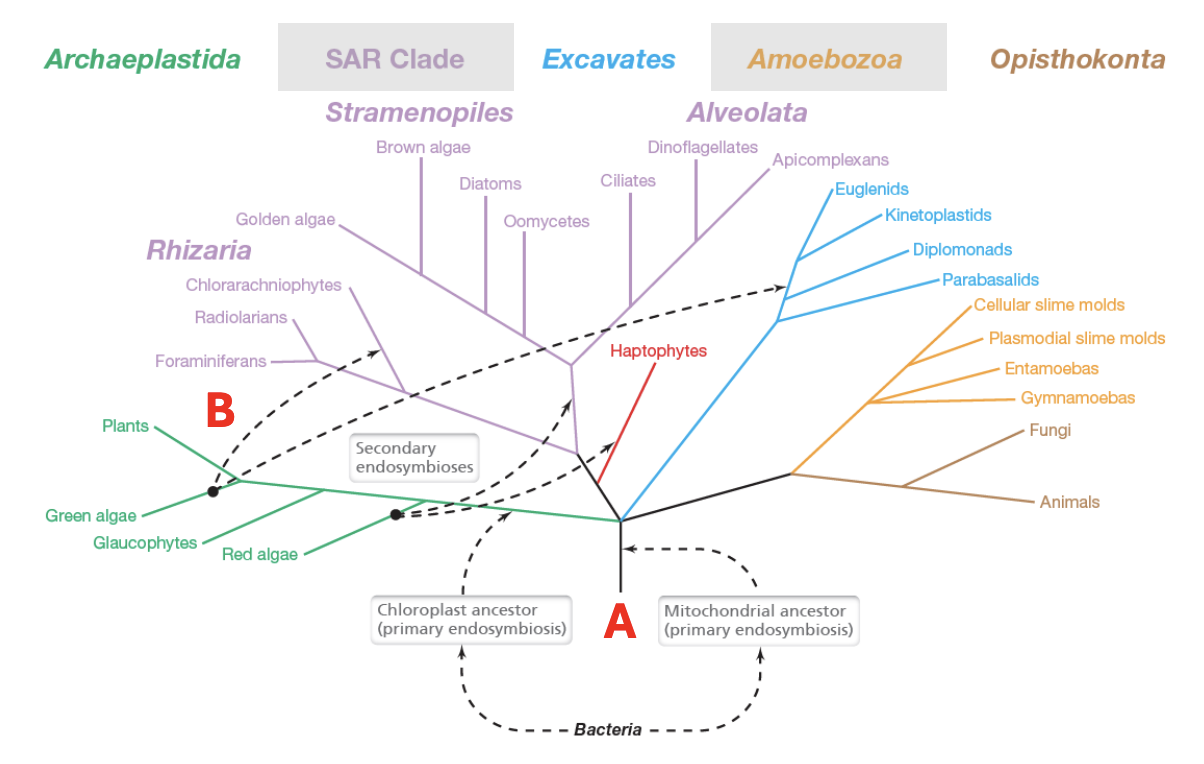
_ were foundational events in eukaryotic evolution
Primary, Secondary endosymbiosis
_ is when an aerobic or photosynthetic bacterium was engulfed by archaeal cell, producing Mycota (true fungi) and Amoebozoa (cellular + plasmodial slime molds)
Primary endosymbiosis
2 products of primary endosymbiosis
Mycota (true fungi)
Amoebozoa (cellular + plasmodial slime molds)
*Bc they dont have chloroplasts
T/F: The first eukaryotic cells are aerobic
TRUE
Explain primary endosymbiosis
Loss of rigid cell wall in anaerobic archaeon facilitated HGTs
Phagocytosis and digestion of other prokaryotes (archaeal/bacterial) increased HGTs, speeding up evol processes
Membrane increasingly enclosing chromosome of anaerobic archaeon to protect it
Aerobic bacterium was taken up to live symbiotically as promitochondrion
Development of multiple mitochondria provided energy for evolution of additional membrane systems and much larger cells
First eukaryotic cells are aerobic

_ is when photosynthetic eukaryote was engulfed by another eukaryote, producing SAR clade, which includes protists with common ancestor + Phaeophyta (brown algae)
Secondary endosymbiosis
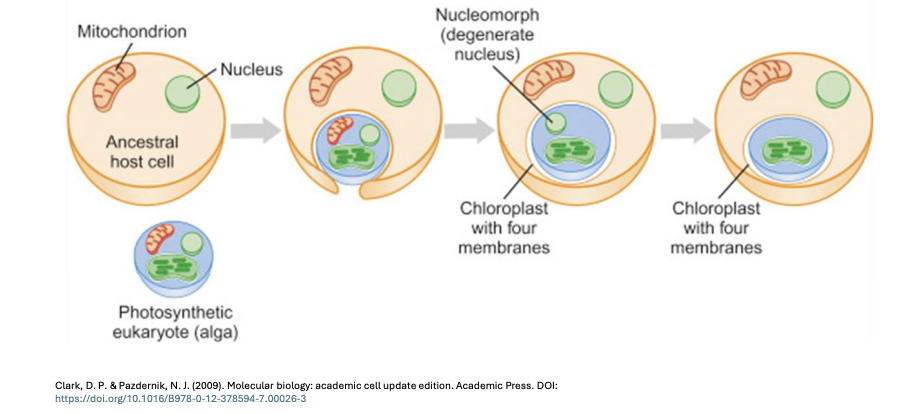
_ are saprotrophic heterotrophs that secrete enzymes to digest food particles from dead organic matter before ingestion
Oomycetes
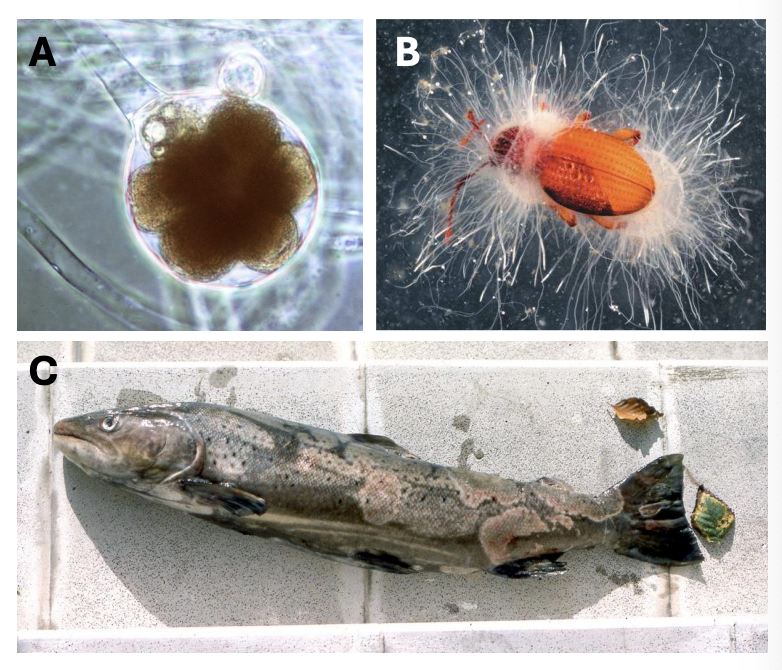
SAR clade includes _ + _
Heterotrophic and phototrophic protists with common ancestor + Phaeophyta (brown algae); Straminopiles, Alveolata, Rhizaria

_ is a clade of eukaryotes with stiff tripartite external hairs
Stramenopiles
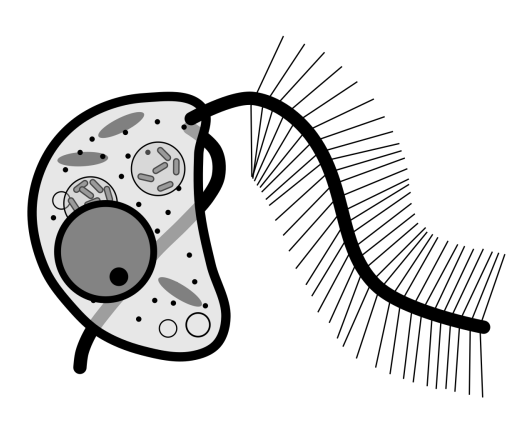
All members of this clade bear flagella with many short, hair-like extensions from which its name is derived from
Members are chemoorganotrophic and phototrophic micro- and macroorganisms
Stramenopiles
3 important fungus-like classes under Straminopiles, example species
loh
Class Labyrinthulomycota
Class Oomycota
Class Hyphochytridiomycota
e.g., Cafeteria roenbergensis = stramenopile heterokont (i.e., cell w 2 dissimilar flagella)

_ is the class of stationary filamentous “water molds” and their terrestrial relatives
Oomycetes
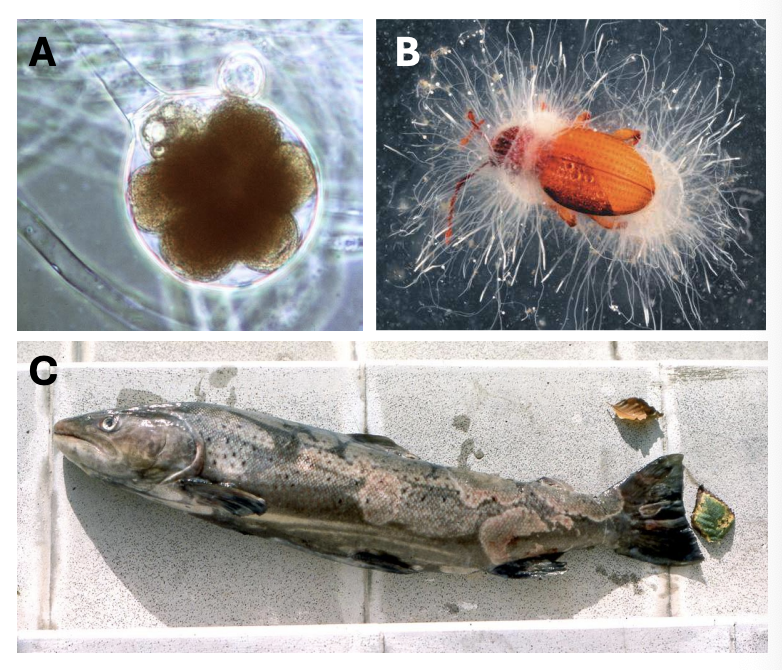
T/F: Oomycetes are called “water molds” because they’re mostly found in water
TRUE
Oomycetes are saprotrophic heterotrophs because _
they secrete enzymes to digest food particles from dead organic matter before digestion
T/F: Oomycota can act as plant and animal parasites/pathogens
TRUE
Oomycota was previously grouped with fungi (Mycota) because _
Unlike fungi, however, they have cellulose in their cell walls and have a diploid (2n) vegetative state
zfc
Ability to make zoospores
Filamentous growth
Presence of coenocytic hyphae that develops into a mycelium

Oomycota was previously grouped with mycota because of their ability to make zoospores, their filamentous growth, and presence of coenocytic hyphae that can grow into mycelia zfc
Unlike fungi, however, they _
Have cellulose in cell walls
Have diploid (2n) vegetative state
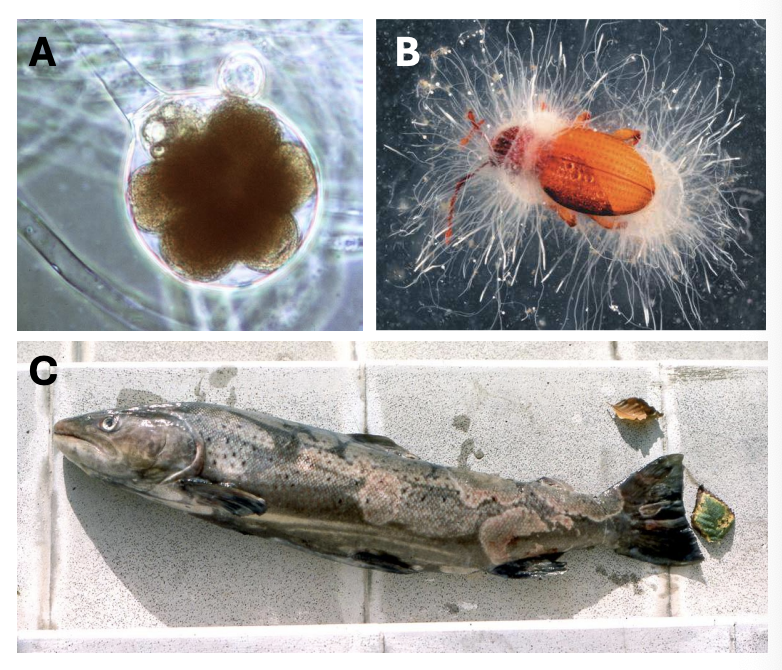
Oomycetes reproduce through _
zoospores, oospores
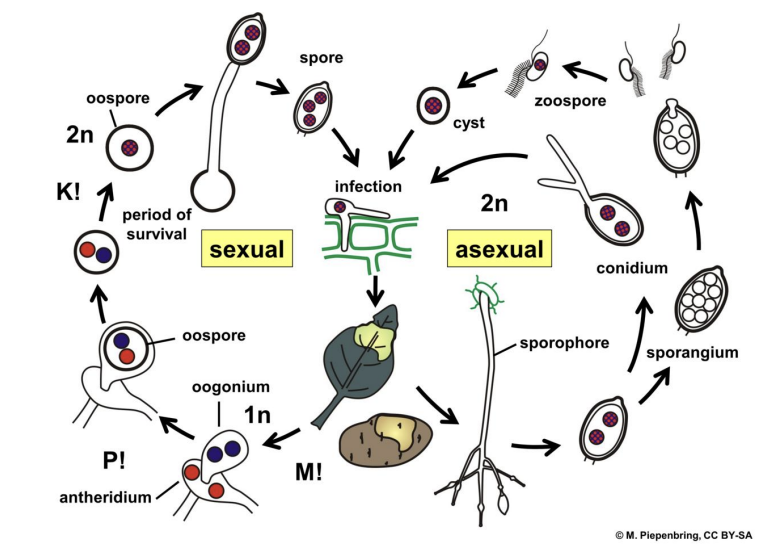
In oomycetes, _ is used as main dispersal mechanism via zoospores capable of chemotaxis in surface waters and water films; some have wind-distributed spores
asexual reproduction
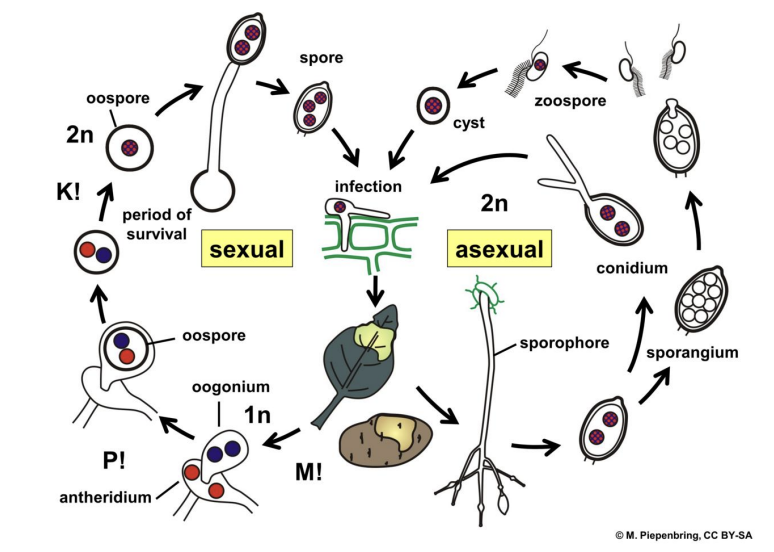
In oomycetes, _ is achieved using oospores, which are double-walled, stress-resistant and form from fusion of oogonium + antheridium (n+n), undergoing plasmogamy to become diploid (2n)
Sexual reproduction
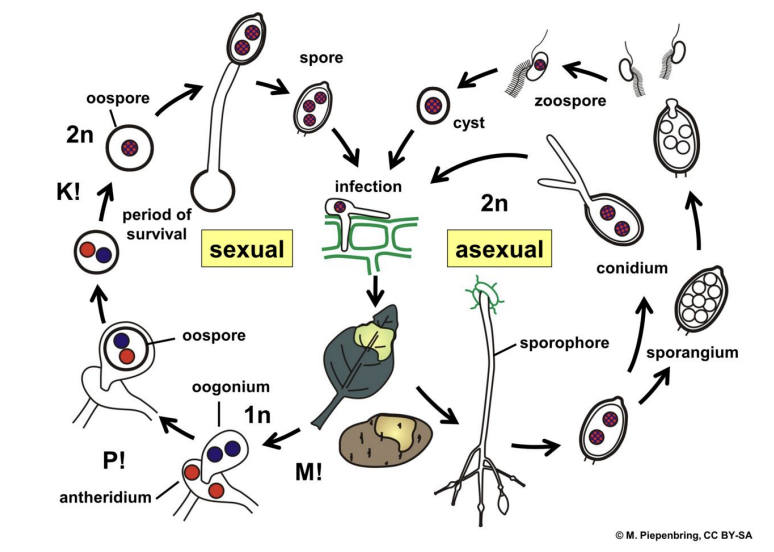
Describe Oomycota life cycle
Asexual
Either zoospores (motile, flagellated sexual) from sporangium encyst or conidia (nonmotile, asexual) infects host epidermal cell, causing diseased structures
Inside host, hyphal structures (2n) form sporophore that can differentiate into either sporangium, producing motile zoospores, or asexual nonmotile conidia which can reenter life cycle
Sexual
2n spores germinating into 2n hyphae infect host epidermal cell, causing diseased structures
Inside host, 2n hyphae undergo meiosis, forming 1n oogonium and antheridium, which can then undergo plasmogamy to form (n+n) oospore
Oospore undergoes period of survival, eventually undergoing karyogamy to produce 2n oospore
2n oospores matures into thallus, which can then release 2n spores, which can then be dispersed and restart life cycle
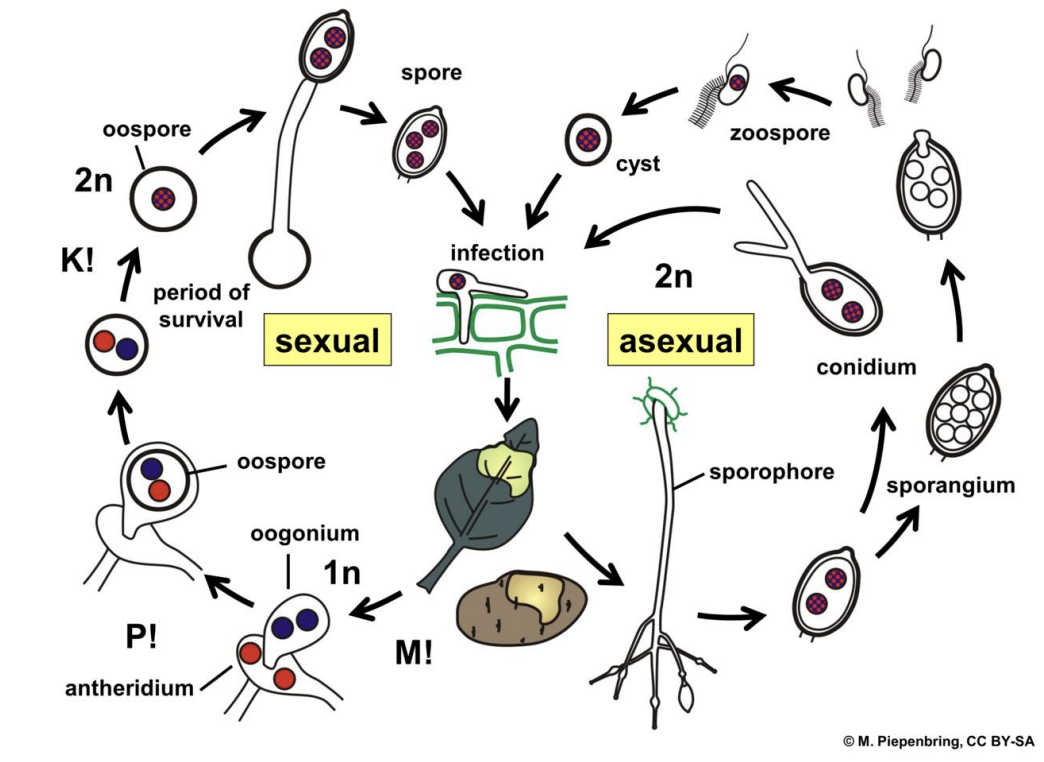
_ is a class of heterotrophic protists that produce networks of filaments or tubes that function as “tracks” for cellular gliding movement or nutrient absorption
Labyrinthulea
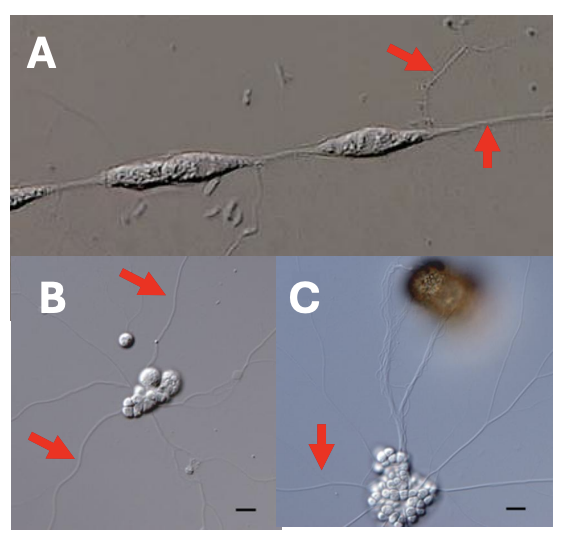
_ are mostly marine and found as parasites of algae and seagrass or as saprotrophs
Labyrinthulea
T/F: One distinguishing feature of Labyrinthulids is that they create membrane-surrounded filaments connect to cytoplasm which encloses thraustochytrids and surrounds labyrinthulids (ectoplasmic nets)
FALSE
One distinguishing feature of Labyrinthulids is that they create membrane-surrounded filaments connected to cytoplasm which encloses Labyrinthulids (ectoplasmic nets) and surrounds Thaustrochytrids
2 main groups under Labyrinthulea
Labyrinthulomycota (A) = slime nets
Thraustochytridiomycota (B-C) = saprotrophic decomposers

Both Labyrinthulomycota and Thraustochytridiomycota have _
biflagellated zoospores

_ have several fascinating fruiting body forms
Slime molds
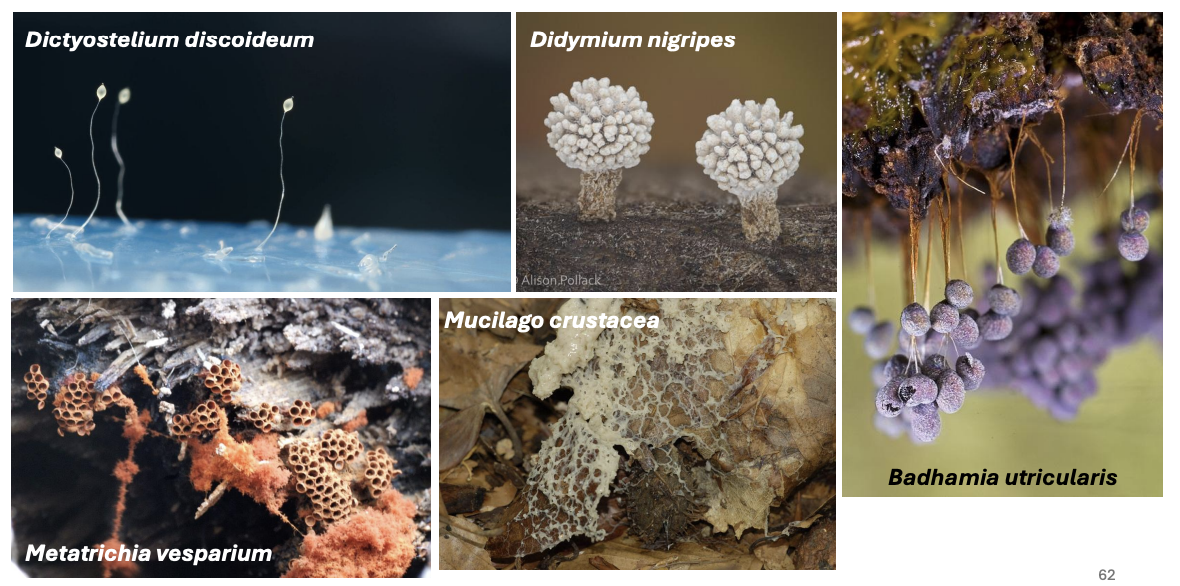
Unique feature of Labyrinthulea
Create membrane-surrounded filaments connected to cytoplasm which enclose Labyrinthulids (ectoplasmic net) and surround thraustochytrids

_ are saprotrophic and parasitic protists that create filaments for movement and feeding
Labyrinthulea
T/F: The predominant life cycle of Labyrinthulomycetes is sexual
FALSE
The predominant life cycle of Labyrinthulomycetes is asexual

T/F: Labyrinthulea have motile zoospores in their life cycle, but asexual reproduction is predominantly utilized
TRUE
T/F: In Labyrinthulea, sexual reproduction is present from gametes derived from sporangia but not well-described
TRUE
Describe Labyrinthulea (Thaustrochytrid) life cycle
Vegetative reproduction begins with mononucleated cell that divides to for multinucleated cells, which develops into sporangia that eventually releases its zoospores which can become mononucleated cells again, restarting cycle
Mononucleated cells can also enter amoeboid loop by undergoing binary division, forming cell cluster that eventually develops into amoeboid cell and multinucleated amoeboid cell, eventually developing into sporangia > release zoospores > become mononucleated cells > re-enter amoeboid loop
Mononucleated cells can also divide to form sporangia containing gametes, which are eventually released. Gametes of opposite mating types fuse, forming 2n zygote
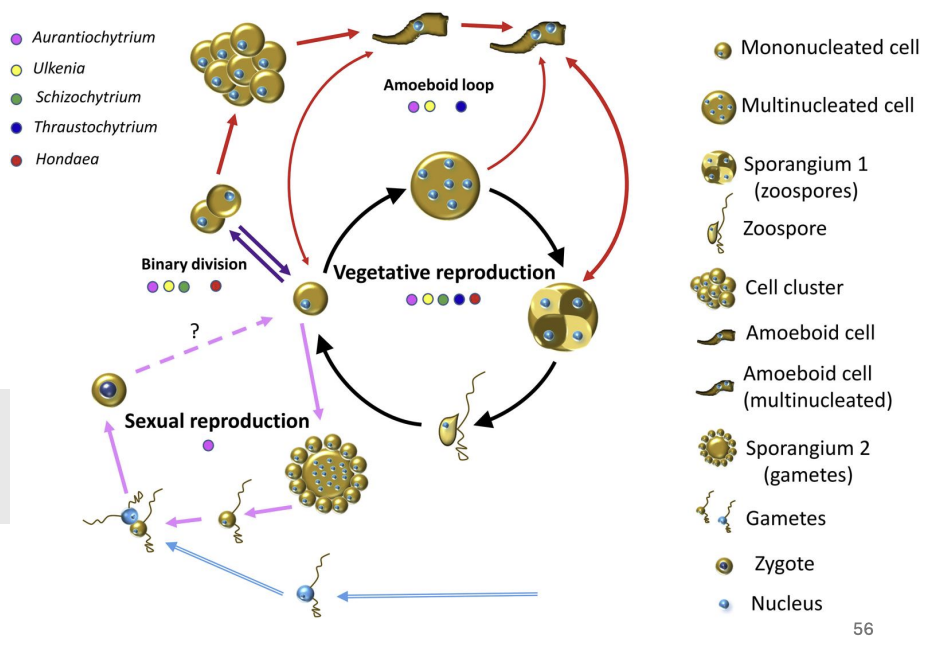
T/F: Thaustrochytrids are well-studied because they produce fatty acids good for human health (DHA)
TRUE
_ is a small group with 6 genera (1/2 dozen), characterized by simple nonmycelial holocarpic thallus (whole cells mature into sporangium)
Hyphochytriomycetes
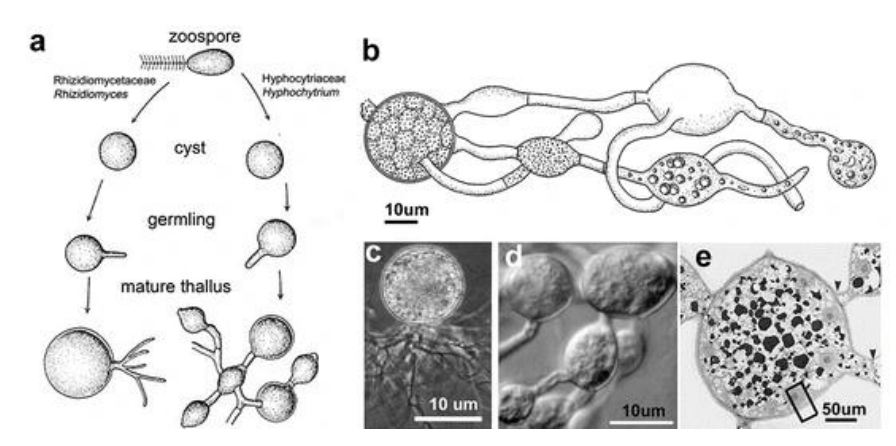
_ feed on decaying matter and maintain themselves for extended period of time in a vegetative state
Slime molds (amoebozoa)
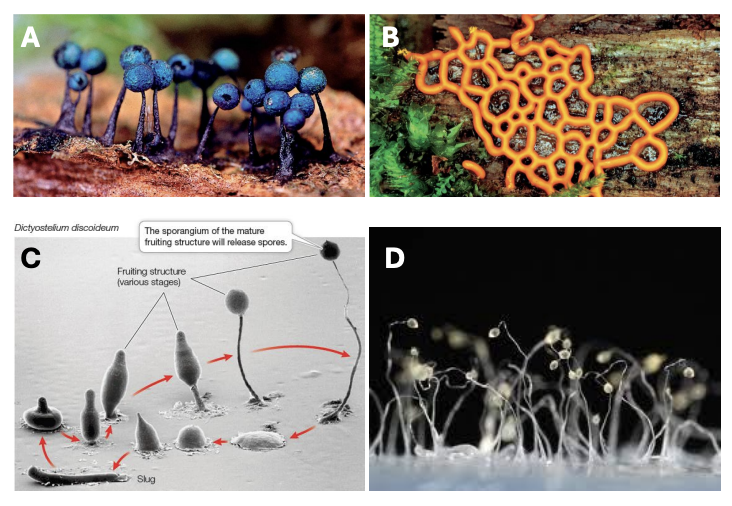
_ is a group of organisms whose whole cells mature into sporangium
Hyphochytriomycetes

_ is a group composed of organisms that produce cells that develop into sporangia
Hyphochytriomycetes
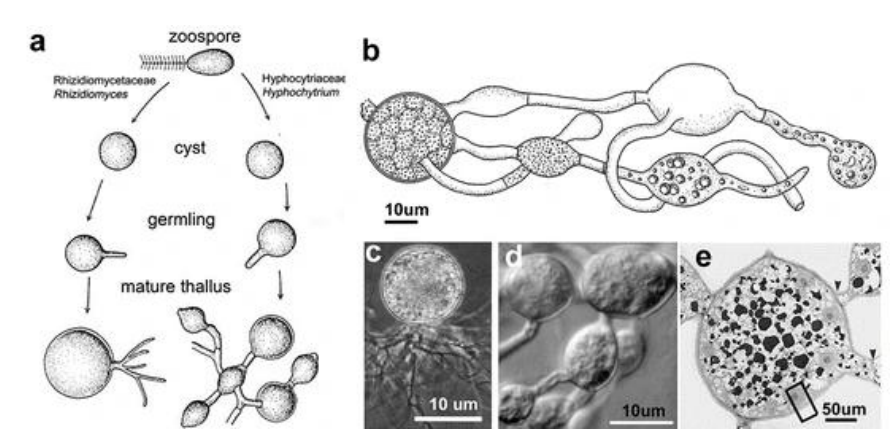
_ are widespread in occurence, mostly saprotrophs or parasitic, infecting resting spores of Oomycota and Glomeromycota
Hyphochytriomycetes
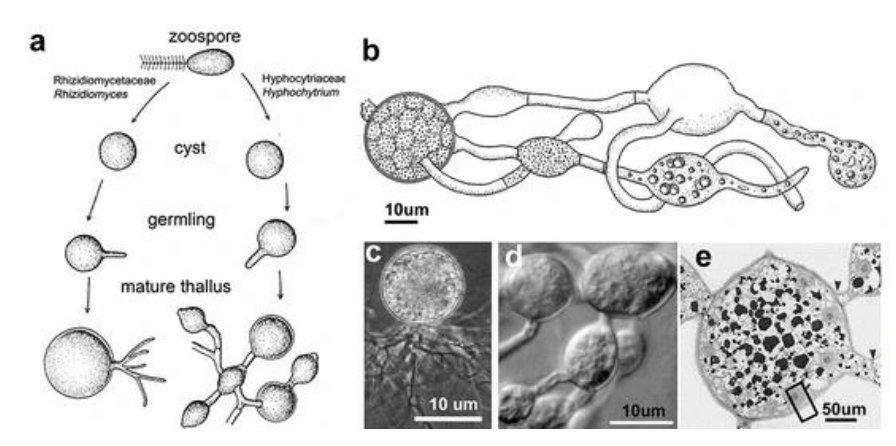
Describe life cycle of Hyphochytriomycetes
Normally
Zoospore > Cyst > Germling > Mature thallus (but not entire cell becomes thallus)
Hyphochytrids
Zoospore > Cyst > Germling > Whole cell becomes sporangium/thallus

Slime molds are amoebas once thought to be fungi due to _
lsf
Similar life cycles
Production of spores and fruiting bodies
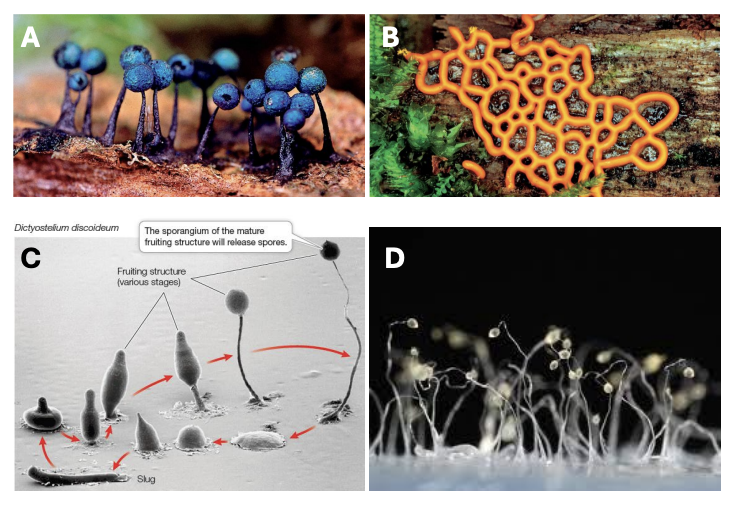
_ refers to vegetative structure in slime molds that engulfs materials in its path
Plasmodium
_ are a nonwalled, multinucleate mass of cytoplasm that forms the plasmodium (vegetative structure that engulfs materials on its path)
Plasmodial slime mold
_ has a vegetative structure that is a single amoeboid cell; cells can swarm and form pseudoplasmodium during nutrient depletion and also form sporangia
Cellular slime molds
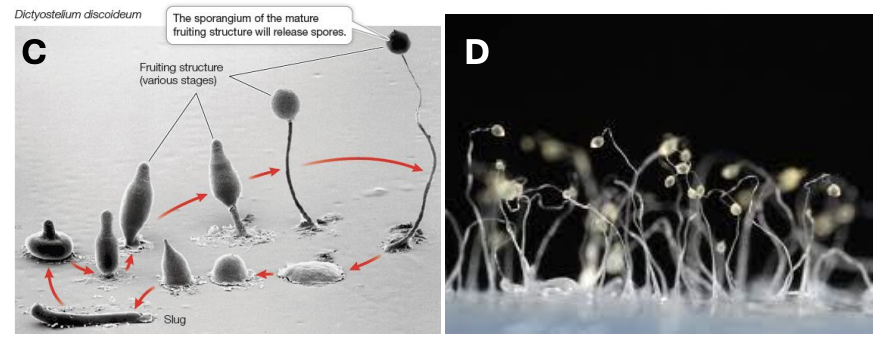
_ are the only macroscopic slime molds
Plasmodial slime molds (Myxomycota)
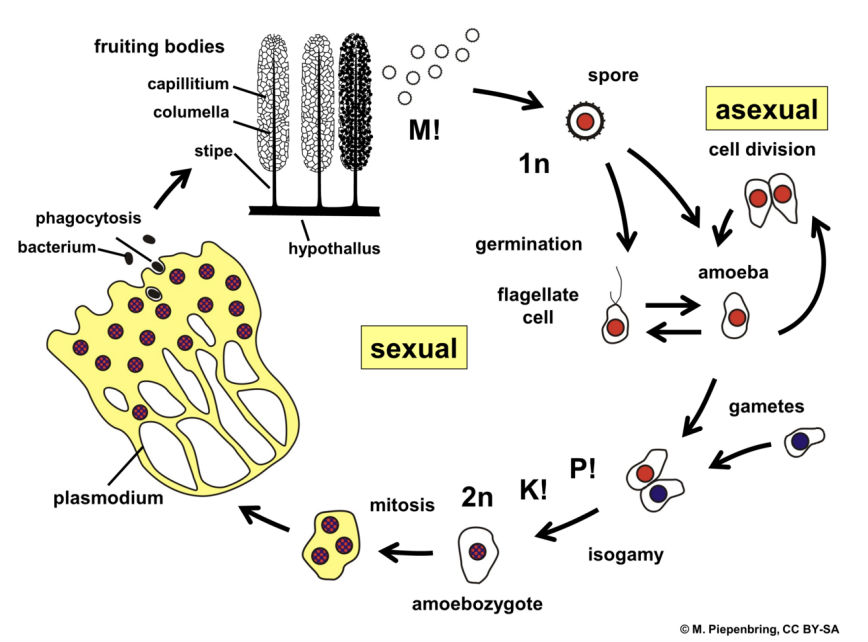
Explain Plasmodial Slime Molds (Myxogastria) life cycle
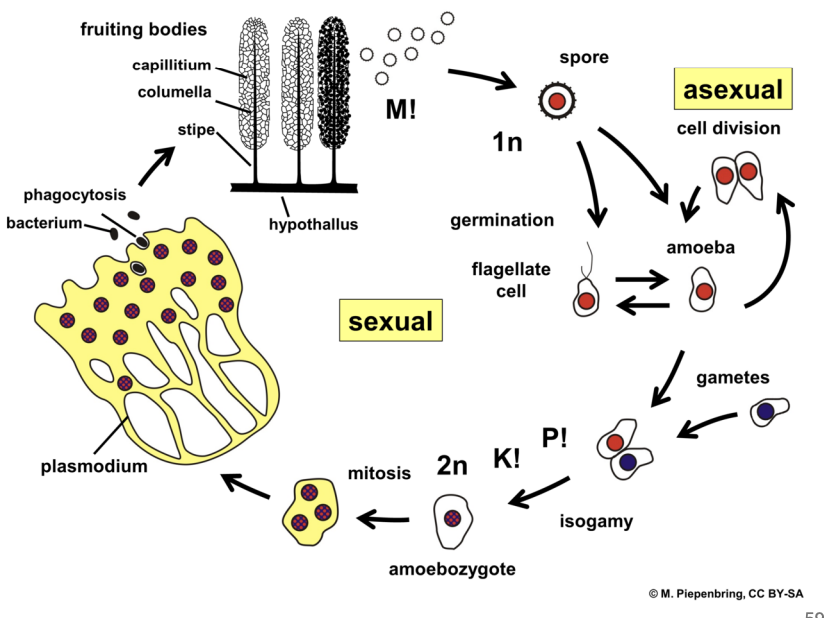
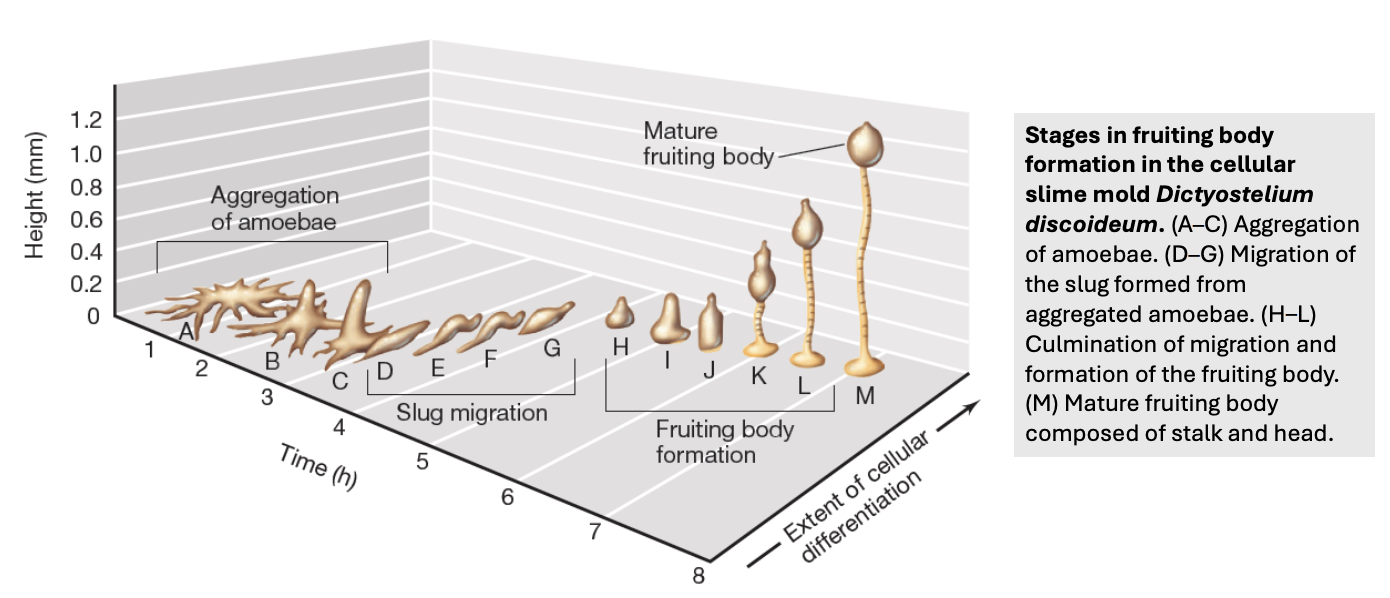
_ can aggregate to form microscopic fruiting bodies
Cellular slime molds
Cellular slime molds can aggregate to form _
microscopic fruiting bodies
Explain life cycle of Dictyostellida
amcm
Aggregation of amoeba
Migration of slug from aggregated amoeba
Culmination of migration and formation of fruiting bodies
Mature fruiting body w stalk and head
